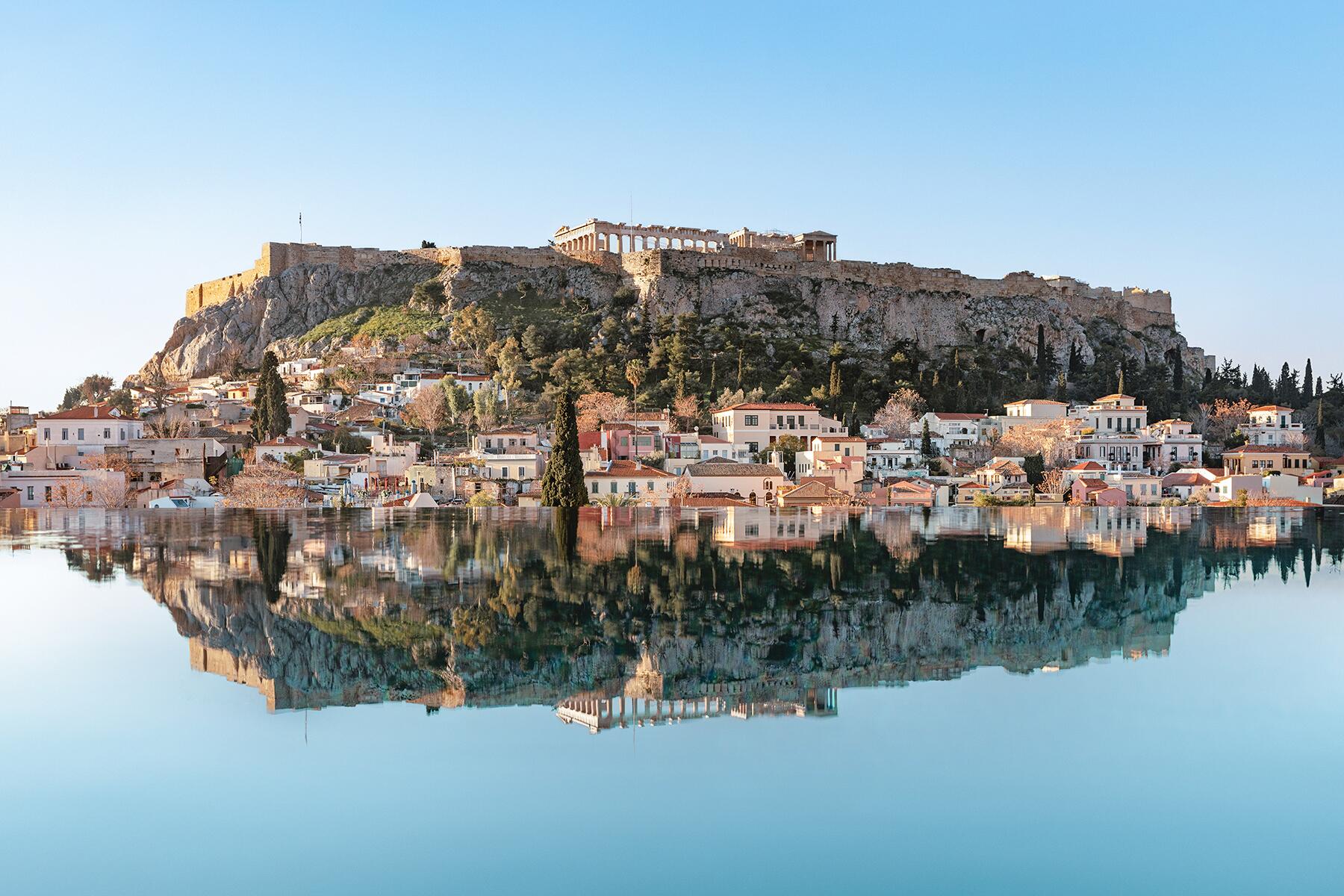From remote hideaways melting into the Utah desert to mirrored cabins reflecting Uruguayan mountains, these hotel hideouts appear to vanish into their natural surroundings.
We’ve seen beachfront villas spring up on far-flung shores. We’ve watched safari lodges open up the wilds. Desert camps inch further from civilization, and mountaintop retreats soar to ever-higher peaks. But now hotels are taking it to the next level, not only unlocking the beautiful landscapes they inhabit but almost becoming a part of them. From those concealed by rocky ravines to others swallowed up by hills or mirrored by towering pines, these hotels are so well hidden they’re practically invisible.
Top Picks for You
Amangiri
WHERE: Canyon Point, Utah
There are desert hideaways, and then there’s Amangiri. This off-grid retreat is tucked away in the remote reaches of Canyon Point. It’s difficult to get to, but that’s the beauty of it. Amangiri melts into the otherworldly landscape of Colorado Plateau, a crinkled expanse sculpted into rock whorls in Southern Utah. The 34-room hotel wraps around a sandstone escarpment, working with the environment—not against it. This adds to its appeal; the swimming pool curving around a 164-million-year-old rock is a knockout. Views are incredible: a shifting spectacle of color, from honey-dipped sandstone spires at daybreak to fiery red mesas as the sun sinks. The spa is huge at 25,000 square feet, with a lantern-lit outdoor pool and Navajo-influenced treatments. Utah is made for outdoor adventures, with the iconic national parks ripe for exploration: Grand Canyon, Bryce Canyon, Zion.
INSIDER TIPTest your mettle on Amangiri’s via Ferrata; the views from the top of the towering rock formations are worth the dizzying climb.
Palacio de Sal
WHERE: Uyuni, Bolivia
We’ve seen hotels made from ice, now it’s salt’s turn. Fifteen miles from the nearest town, the isolated Palacio de Sal rises from the banks of the world’s largest salt flats, Salar de Uyuni, in southwest Bolivia. From afar, the hotel disappears when you blink, re-emerging like a mirage on the stark lunar landscape. It’s made entirely from salt, from ceilings and walls to furniture and sculptures. The boundaries between design and nature blur; as hazy as the horizon of the salt flats during the rainy season. That’s not to say this hotel is as barren as its surroundings; there’s a saltwater pool, spa, salt sauna, bar, and restaurant—seasoning is optional. Domed rooms mimic salt igloos, with salt-brick ceilings and beds made of salt. There’s a strict rule that guests can’t lick the walls to avoid damaging the structure (hopefully this was a preventive measure, rather than reactive).
INSIDER TIPSign up for a tour of the world’s biggest salt flats through the hotel, but remember your high-protection sunglasses—the reflection on the white expanse is dazzling.
Recommended Fodor’s Video
Sacromonte Landscape Hotel
WHERE: Maldonado, Uruguay
Uruguay may often be overlooked for its bigger cousins Brazil and Argentina, but South America’s tiniest country packs in some dramatic landscapes. Golden beaches line the Atlantic coastline, while inland, craggy sierras give way to sprawling vineyards and river-threaded valleys. It’s this rural environment that camouflages the Sacromonte Landscape Hotel. Thanks to a mirrored facade, the 13 cabins reflect the sky, clouds, and mountains, while their grass-clad roof blends in with the hills from above. The tinted glass allows for stunning views of the neatly combed vines and Sierra Carapé from within—while concealing guests inside. There’s a winery with vineyard tours and sunset tastings, and a farm-to-fork restaurant serving Uruguayan dishes like wild boar or roast lamb.
INSIDER TIPTake suitable activewear as you can go horse riding among the forested mountains.
Tierra Patagonia
WHERE: Patagonia, Chile
On the shores of Lake Sarmiento, Tierra Patagonia weaves into the rugged surroundings, mushrooming from the environment. The low-slung arc of wood and glass becomes part of the dramatic backdrop: the granite peaks of Torres del Paine in Chile. It’s all about the views here. The glass walls frame swathes of untouched national park—from rooms, from the restaurant, the terrace, the spa, even the bathtubs. The Patagonian landscape beyond the full-length windows of the infinity pool makes for soul-soothing spa sessions. While you’re wallowing in the outdoor hot tub, a herd of wild guanaco (native cousin to the llama) may roam by.
INSIDER TIPIt’s a bit of a slog from Punta Arenas—four hours by car—so try to fly to Puerto Natales to skim three hours off the journey from the airport.
Perivolas Hideaway
WHERE: Therasia, near Santorini, Greece
Santorini is a victim of its own success: the beauty of its cliff-clinging sugar-cube towns lures ever-more visitors to the island—yet Greece’s most photogenic spot is struggling to keep up with the influx. To help ease the pressure, head west across the caldera to Santorini’s tranquil alter-ego, Therasia. The untamed island is all volcanic beaches and red-rock cliffs. It’s this ochre landscape that conceals Perivolas Hideaway, a five-bedroom villa built from the ruins of a former pumice mine. The edifice merges into the foot of a cliff, vanishing almost entirely into the rock face. You can only access the property by helicopter or boat (three minutes from Santorini by speedboat), like something out of James Bond. The Aegean wraps around the secluded retreat, lapping at the outdoor terraces and the seawater infinity pool. From here, you can take in Santorini’s iconic sunsets—without the crowds.
INSIDER TIPMake the most of the private PADI diving center and watersports center; pick from water-skiing, windsurfing, wakeboarding, kayaking, or snorkeling.
Sextantio le Grotte della Civita
WHERE: Matera, Italy
Barely half a century since it was cast as the “shame of Italy” for its dire poverty, Matera is a city reborn. In the 1950s around 15,000 troglodytes (cave-dwellers) were relocated to modern housing and the deserted Basilicatan town was abandoned. Now a UNESCO World Heritage Site and European Capital of Culture for 2019, Matera is on the rise. It’s an extraordinary place: a sheer ravine honeycombed with Paleolithic cave dwellings, which later grew into two sassi (“stone”) districts of huddled houses and rock churches. In recent years many grottos have been transformed into restaurants, bars, and hotels—including the jaw-dropping Sextantio le Grotte della Civita. The ancient cave complex has been carefully converted into 18 minimalist rooms that honor original features; crumbling tufa limestone walls, cobbled floors, and rough-hewn stone arches. The Tasting Room is set in the former church, Cripta della Civita, and is a standout breakfast spot.
INSIDER TIPThe best way to explore Matera is to simply get lost in the web of narrow alleys and zigzagging staircases to stumble across abandoned sassi dwellings, piazzas, and chiese rupestri (cave churches).
Alto Atacama Desert Lodge & Spa
WHERE: San Pedro de Atacama, Chile
Alto Atacama Desert Lodge & Spa is a cool retreat from the Atacama, the highest and driest desert in the world. This adobe-walled wilderness lodge is cradled in the belly of Catarpe Valley; its soft apricot tones are almost hidden among the blushing landscape. Views of the Salt Mountains are best taken in from the fire pit at dusk when the failing light turns the towering peaks mauve. The outdoor baths of the partially sunken spa are filled with water from underground springs, while a further six plunge pools are scattered throughout the grounds—a respite from the intense heat. This corner of Chile is an adventure lover’s playground, from the ethereal Moon Valley to geysers at El Tatio and the Salar de Atacama salt flats. The Atacama, 7,900 feet above sea level, is also one of the best stargazing spots, with little light pollution.
INSIDER TIPBe sure to apply sunblock; you’ll need it in the dry, high-altitude desert.
The Mirrorcube
WHERE: Harads, Sweden
This treehouse isn’t the rickety wooden affair from your childhood, but it is just as nostalgic. The cleverly designed treetop hideout mirrors the towering pines and ice-blue sky of northern Sweden, camouflaging it among the branches. Trees were not cut down to accommodate The Mirrorcube but rather aided its construction; a single trunk rises through the living space, supporting the structure and doubling as a natural design feature. Access is via a rope bridge, and the space-savvy interior (Scandi-minimalist, of course) makes room for a double bed, toilet, lounge, and roof terrace. In case you’re worried birds may not see the hidden refuge, a transparent infrared film in the glass prevents collisions. The Mirrorcube is part of Treehotel’s collection of somewhat bizarre treehouse designs, including a bird’s nest and UFO.
INSIDER TIPShowers and a sauna are in nearby buildings, and meals are served in the guesthouse—or delivered directly to your perch.
Adrère Amellal Desert Ecolodge
WHERE: Siwa, Egypt
If you want to escape the tourist trail, Siwa is an isolated desert oasis on the edge of the Great Sand Sea, inhabited by Egypt’s only Berber community. Resembling a movie set, Adrère Amellal Desert Ecolodge is made from honey-colored kershef stone—the exact shade of the limestone cliff looming behind it. The higgledy-piggledy cluster of buildings, connected by a maze of corridors and staircases, is inspired by the ancient village of Shali, whose fortress ruins lie atop a hill at the heart of the oasis. This is all about a traditional way of life; beeswax candles illuminate rooms and water is sourced from natural springs. You can swim in the spring-water pool or saltwater lake, and intrepid types can take a 4WD safari across the undulating dunes.
INSIDER TIPCharge your phone fully and switch it to battery-saving mode if you want to eke out as much usage as possible; alternatively, embrace a digital detox.
Casas Cuevas del Tío Tobas
WHERE: Guadix, Spain
Like hobbit homes from Lord of the Rings, the cave houses of Cuevas del Tío Tobas are swallowed up by a grassy hillside in Guadix, an ancient city in Granada. For hundreds of years, the trogloditas of the Barrio de Cuevas (Neighborhood of Caves) have lived in subterranean homes, carved into a rocky plateau at the foot of Spain’s Sierra Nevada. You could walk above these lodgings without knowing they exist, with the white chimneys the only giveaway. From the front, however, many look like your standard Andalusian abode: whitewashed facades punctuated with wooden shutters and arched doors. Others are hidden within the folds of russet-colored hills, disguised behind cliff faces, or covered by scrubby grass. The 19 casas at Cuevas del Tío Tobas remain rooted in time, cozy cocoons with stone walls reaching up to rough-hewn curved ceilings, dotted with natural enclaves.
INSIDER TIPIf you’re traveling with kids, pick The Picón for an additional sofa bed and enough space for four.









